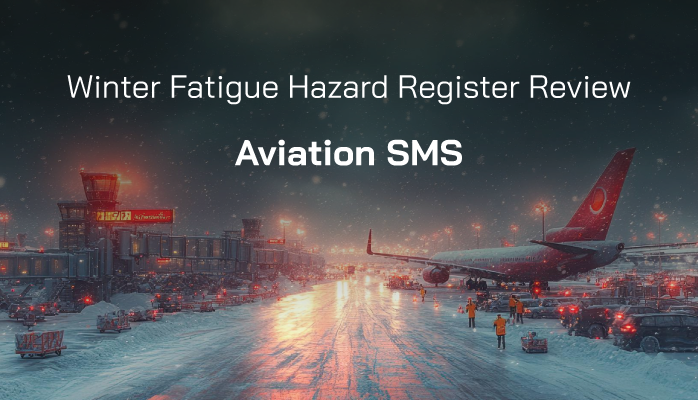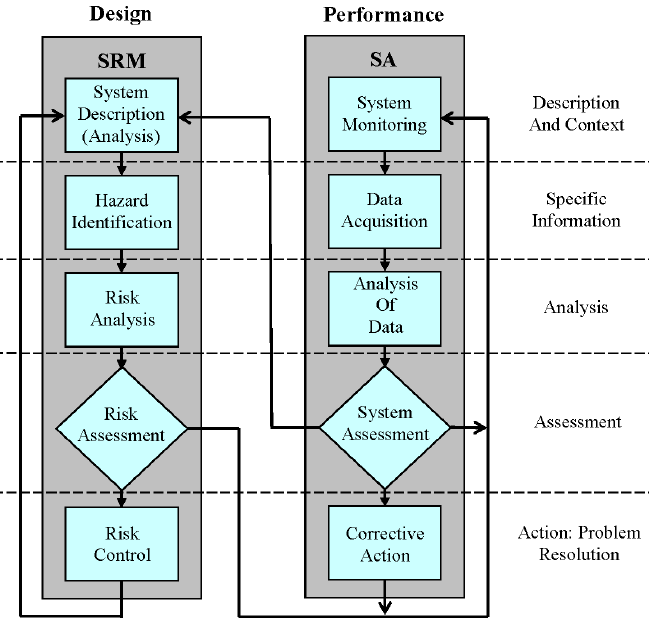Winter Is Coming - Move Fatigue Upward in Hazard Register

The Northern Hemisphere is blanketed in winter, which involves, cold, ice, many long nights, and grey days.
For human fatigue that means two things:
- More melatonin production
- Seasonal depression
Winter fatigue is a real, medically proven problem that affects many people.
Related Articles on Fatigue Risk Management
- How to Best Monitor Fatigue in Your Aviation SMS
- 3 Ways for Dealing With Fatigue Risk Management in Aviation SMS
- How to Incorporate Fatigue Risk Management into Aviation SMS
When safety managers are reviewing hazard registers in their aviation safety management systems (SMS), they should be moving these following related items toward the top of their hazard register, where they will not be overlooked:
- Fatigue;
- Seasonal effect;
- Cold; or
- Weather.
You do have a hazard register, right?
What Is a Hazard Register?
The hazard register is the output of your system's proactive hazard identification and analysis activities. During this process, safety managers and operational department heads will:
- Describe each system;
- List hazards affecting operations in this system;
- List hazard-related consequences (safety risk analysis using risk scenarios);
- List existing control measures that mitigate risk related to each hazard;
- Conduct a risk assessment to determine whether the risk is acceptable;
- Design and implement additional risk controls when necessary;
- Monitor and repeat as needed.
Who Participates in Proactive Hazard Identification?
I'm hoping you did not overlook who is participating in the proactive hazard identification process. Proactive hazard identification is also a safety risk management (SRM) activity that is closely intertwined with your aviation SMS' safety assurance (SA) processes. Proactive hazard identification and analysis requires participation from:
- the safety team,
- operational department heads; and
- subject matter experts.
The larger your company and the more complex it is, you will need to involve more personnel who are intimately familiar with the operations':
- common hazards encountered during the conduct of routine and non-routine operations;
- probability and severity of hazard-related consequences should a hazard manifest itself; and
- risk control strategies for relevant hazards.
Related Aviation SMS Hazard Register Articles
- What Is a Hazard Register?
- Tips Tying Corrective Action Preventive Action to Hazard Register
- Understanding Proactive Hazard Management in Aviation SMS
How Often to Review Aviation SMS Hazard Register?
Hazard register requires regular reviews. And being reviewed by the safety manager is not good enough.
How regular?
Who else should review the hazard register?
At a minimum, hazard registers should have each hazard's related documentation reviewed annually by the manager with risk acceptance authority over the system. For each hazard, the operational department head should review for accuracy the:
- System description;
- Hazard description;
- Whether hazard is a key performance indicator (KPI);
- Whether safety reports related to hazard require investigations and at which risk levels?
- Automated alert settings to notify management of developing trends;
- Hazard related consequences;
- Implemented risk controls;
- Planned risk controls or those currently being implemented;
- Number, type, and severity of reported safety issues resulting from this hazard;
- Number, type, and severity of audit findings related to this hazard; and
- Any other relevant documentation available to management to help manage the hazard.
The above guideline was a minimum and not a suggested best practice. Let's dig in more.
When Else Should Hazard Register Be Reviewed?
SRM activities generate the hazard register.
The hazard register represents the systems' design.
When the system is performing, i.e., operators are conducting business according to their missions, hopefully making money or satisfying their mission to the aviation industry. Planes are taking off and landing. Passengers are enplaning and deplaning. Maintenance and baggage handlers are supporting aviation operations. A lot is going on. People are busy. Employees are commonly fighting a schedule or management's desire for higher production. What could go wrong?
The "system" designed in the SRM processes will need to be monitored using the Safety Assurance (SA) processes. SA gives management assurance that the system's design is sound and the system is performing satisfactorily.
Related Aviation SMS Safety Assurance Articles
- Best Tip for Safety Assurance Monitoring in Aviation SMS
- 40 Questions for Your Safety Assurance Process in Aviation SMS [With Free Checklists]
- Safety Assurance in Aviation SMS? Will Your Boss Scream?
The two most popular SA activities are:
- Safety reports by employees, vendors and stakeholders; and
- Audit findings (both internal and external);
If you have not noticed, these are "system monitoring" processes that allow management to monitor the system and address any substandard safety performance. See the image below.

As safety reports and audit findings enter the SA process, each "issue" will have a safety risk analysis performed. When will the risk analysis be performed? Don't think that you have to follow this model above exactly. It is a simplified representation of the risk management processes that are expected to occur when "issues" enter the risk management system.
During the investigation of the safety issue, safety managers (or committees) may conduct an initial risk assessment and assign the safety issue to an operational department head with risk acceptance authority over this area of operations. This may not always be the same manager. For example, one manager may be assigned to safety issues with risk assessments of
- "Acceptable risk" and
- "Acceptable with Mitigation"
While another upper-level executive may be required to manage and accept safety issues that have been risk assessed as "Intolerable."
The point is that safety teams and responsible managers should be reviewing hazards, risks, and risk controls of related hazards whenever safety issues are being processed through the risk management system.
Your SMS manual's documented processes may be different from these; however, these considerations must be accounted for. For example, your SMS processes may only require hazard reviews when safety issues have been risking assessed at anything higher than "Acceptable risk."
One further consideration is what should happen when a reported safety issue or audit finding is a KPI or triggers an investigation. These are times when the related system and associated hazard documentation should be reviewed regardless of risk assessments' results.
Related Articles on Risk Assessment in Aviation SMS
- 5 Questions to Ask before Making Risk Assessment
- How to Assign Severity and Likelihood to Issues When Assessing Risk
- How to Create Your Risk Matrix for Risk Assessments in Aviation SMS
Reasons Aviation Service Providers Neglect Hazard Register

We see many operators neglecting their hazard registers. The most common reasons are:
- Hazard registers are in disconnected systems or spreadsheets;
- Poor safety culture (lack of management support);
- Lack of training;
- Safety manager historically reviewed hazard register without management involvement;
- Operator is too simple or small to develop a hazard register.
When the hazard register is too difficult to update or review, the process is not sustainable. Unsustainable risk management processes are intolerable risks to the aviation SMS.
We've laid a lot of groundwork to address our fatigue issue. When winter fatigue becomes a recurring issue in your company, how do you manage the hazard?
- Do you review the fatigue documentation?
- Do you review documented risk scenarios related to fatigue?
- Do you review the implemented risk controls?
- Do you evaluate the implemented risk controls?
Reviewing and evaluating risk controls are not the same. Reviewing is simply looking at the control's documentation without adding any long-term value. A better strategy for monitoring risk controls is to evaluate instead of review. A simple strategy to evaluate risk controls is to use an intuitive scale, such as
- Performing as designed / Not performing as designed; or
- Effective / Not effective.
When you evaluate risk controls, you are documenting the control with a "Vote in favor" or "Vote against" the performance of the risk control. So in the case of winter fatigue, you can go through each risk control and document whether the risk control is performing as designed.
As we have seen so far, there are multiple times when hazards residing in your hazard register need to be reviewed. Let's continue reviewing our winter fatigue hazard.
Related Articles on Monitoring Effectiveness of Risk Controls
- Difference Between Hazards, Risks & Control Measures in Aviation SMS
- How to Monitor the Effectiveness of Control Measures
- How to Implement Effective Control Measures
Hazard Analysis Software Tools Make Life Easier for Safety Managers
The chronic tiredness of winter months can range from feeling like you are "made of lead" or feeling "out of it", to having trouble staying awake. Generally, people who show signs of fatigue may walk very slowly or stumble, drop things, or even fall asleep while on duty.
Fatigue in aviation is an interesting safety hazard to manage in your proactive hazard identification and analysis activities because it bleeds into almost every other element in an aviation service provider's hazard register. Fatigue:
- Lowers stress tolerance and ability to deal with pressure
- Slows the brain, i.e. lack of vigilance
- Makes workers more prone to distraction
- Decreases vigor
- Breeds moodiness and/or complacency, i.e. lack of teamwork
- Reduces assertiveness and the ability to communicate
I would even go so far as to say that, especially in winter, fatigue is perhaps the most pressing of all dynamically changing safety hazards. It's an especially tricky hazard to find effective and universal mitigation techniques for because the root adversary is the environment.
Fatigue Is the No. 1 Dynamically Changing Safety Hazard

The effect of fatigue on the human mind is akin to being intoxicated. For pilots and workers in the aviation industry, this can be deadly.
Studies show that missing just 2 hours of sleep can have the equivalent effect on the brain as a .05% blood alcohol content. Studies also show that landing a plane at 5 am can cause the same impairments in pilots as a .08% blood alcohol content.
For individuals who-
- miss even more sleep
- have compounded fatigue due to seasonal factors
- have stress and increased work hours
-the equivalent blood alcohol content skyrockets.
Roughly 20% of aviation accidents are directly caused by fatigue. We can however assume that the actual number of accidents caused by fatigue is higher because of the "bleedover" effect of fatigue on other human factors.
It is also no secret that as workers' hours increase so too do accident rates. Pilot's accident rate is 1.7 times higher for 10-12 hours of duty time than for 1-9 hours. For duty times of more than 12 hours, the accident rate is even more pronounced.
Unfortunately for many people, the winter months generate the effects of lack of sleep no matter how much sleep an individual gets. Therefore, this dynamic hazard must be regularly reviewed, which requires:
- A responsible manager to ensure it doesn't slip through the cracks;
- Strategy (and tools) to alert the responsible manager to review the mitigation plan;
- Review existing defenses;
- Evaluate or perform the risk assessment on all credible risks associated with the hazard; and
- Incorporate further actions to reduce risks.
Since fatigue is an ever-recurring hazard, there must be a system to effectively manage this hazard. A paper-based system will not adequately ensure this dynamic hazard is reviewed annually. The crudest, most elementary effective means for managing this hazard can be adopted for aviation SMS with extremely limited resources:
- An Excel hazard register; along with
- A calendar reminder is perhaps.
Managing a hazard register stored in a spreadsheet does not allow for the continuous monitoring of the environment and risk controls. This disconnected hazard register from the risk management data causes many audit findings. An effective SMS data management strategy has a hazard register integrated into the risk management system and the system for managing audit findings. If you really want to do this right, you will need an SMS database that allows safety teams to practice sustainable risk management activities.
If your aviation SMS has top management support, they will certainly support safety managers' need for modern aviation SMS tools to save time and more effectively manage hazards. An SMS database is a wise investment.
Related Aviation SMS Database Articles
- What Is an Aviation Safety Database
- 5 Most Important Things to Know Before Buying Aviation SMS Database
- Pros and Cons of In-House SMS Database and Off-the-Shelf-Solutions (COTS)
Fatigue Management as Part of Mitigation Strategy

Getting enough sleep is an obvious mitigation strategy for fatigue management. Many resources talk at great length about getting the appropriate amount of sleep, which generally involves several best practices:
- Don't exercise 2-3 hours before bedtime
- Don't eat or drink too much before bedtime
- Try not to use sleeping pills
- Go to sleep and wake up around the same time if possible
And the list goes on.
Winter Fatigue May Require Different Mitigation Strategies
Fatigue in the wintertime is a different safety hazard than general fatigue and will require different mitigation strategies to combat effectively. Adequate sleep can, for many people, not be a solution to the problem if they are prone to seasonal fatigue.
For aviation safety officers and workers, this means having an alternative approach to wakefulness. Here are several scientifically proven control measures for maintaining wakefulness that you might not otherwise think of
- Drink water. Fatigue for many people is caused or exacerbated by dehydration. Drinking water or tea as opposed to soft drinks is a fantastic way to combat sugar-dive-inducing fatigue.
- Stretch. Interestingly, studies show that getting up and stretching once every hour or two has an immediate waking effect on the body because it reduces tension and causes some discomfort (stretching is not exactly pain-free).
- Eat an apple or banana. No, this is not the "an apple a day keeps the doctor away." Rather, apples and bananas have healthy fiber, sugar, potassium, and carbohydrates that can give the body a slow-releasing sugar boost.
- Eat almonds. Almonds contain omega-3 and omega-6 fatty acids that are excellent for inducing wakefulness and vigilance.
- Avoid heavy sugar foods or too much coffee. I didn't say avoid coffee. A cup or two of coffee to get you going is good, but too much coffee can make you crash, cause headaches, and brain fog. Unhealthy foods cause sugar crashes that can compound someone already struggling with fatigue.
While there is no substitute for sleep, being diligent about the above points can make a major difference for workers who are chronically fatigued or affected by seasonal factors.
Final Thought on Implementing These Control Measures
Successful risk management strategies for fatigue are essential in the winter months. For many people, more than just getting enough rest is needed.
For aviation safety officers, encourage workers and staff to practice the above secondary methods of inducing wakefulness. Check in and see how people are feeling. Monitor and make sure workers are actually following through.
Communicate this information to all employees using:
- Safety surveys;
- Your preferred Safety Message Board;
- Safety meetings; and
- Safety newsletters.
What do you think? How do you deal with fatigue management in your workplace?
How do you monitor your hazards? Are your processes effective?
Proactive hazard identification and analysis activities and hazard/risk registers are elements of maturing (and fully mature) aviation SMS.
SMS database tools simplify these activities in a full-featured, integrated safety and quality management system. This is where aviation risk management software strongly offers your company the required return on investment.
The Risk Management Solution has a hazard register and the necessary tools to both document and monitor risk controls.
If you need tools to effectively manage hazards, please watch these short demo videos.
Live SMS Pro Demo
Have questions? Would you like to see more? Sign up for a live SMS Pro demo.
Last updated in July 2025.
Three Sheets to The Wind Image via HBR









